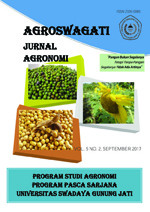PENGARUH KOMPOSISI MEDIA TANAM KOMPOS JERAMI DAN KAPAS TERHADAP KOMPONEN HASIL DAN HASIL JAMUR MERANG (Volvariella volvacea)
DOI:
https://doi.org/10.33603/agroswagati.v5i2.1916Kata Kunci:
Straw Compost, Cotton Compost, Results Of Merang MushroomsAbstrak
The objectives of this study were: (1) To determine the effect of the combination treatment of the composition of the planting media of straw and cotton compost on the yield and yield components of the mushroom (Volvariella volvaceae), and (2) Knowing the combination treatment of the composition of the straw and cotton compost best for the yield components and results of the mushroom (Volvariella volvaceae).
The experiments have been carried out at the Agricultural, Fisheries, Plantation and Forestry Counseling Center (BP3K) in Panguragan District, Kalianyar Village. The trial location is at an altitude of 8 m above sea level. The average daily temperature is 30 0C and the average humidity is 85%. The location selection was based because the Karanganyar village had developed mushroom cultivation. The research period has been carried out for four months starting from September to December 2012.
The results showed that: (1) The combination of the treatment composition of the planting medium of straw compost and cotton compost had a significant effect on the number of fruit bodies per plot and fruit body weight per batch, but did not significantly affect fruit body length, fruit body diameter and weight per fruiting bodies, and (2) In combination with the treatment of planting media straw compost and cotton compost with a ratio of 1: 1, 2: 1, 3: 1, 4: 1 and 5: 1 obtained the number of fruit bodies per plot and fruit body weight per plot tall one.Referensi
A. Karim Makarim., Sumarno dan Suyamto, 2007. Jerami Padi : Pengelolaan dan Pemanfaatan. Pusat Penelitian dan Pengembang- an Tanaman Pangan. Balai Penelitian dan Pengembangan Pertanian. Jakarta.
Balai Pengkajian Teknologi Pertanian Jambi. 2010. Pengembangan Usaha Agribisnis Pedesaan (PUAP) Provinsi Jambi. Dalam : http:jambi.litbang.deptan.go.id. Diunduh tanggal 24 April 2010.
Chang, S.T. 1982. Cultivation of Volvariella mushroom in Southeast Asia, hlm. 221-256. Di dalam ST. Chang & T.H. Quinio ed.,Tropical Mushroom. Hongkong : The Chinese University Press.
Farida Yuliani. 2010. Pertumbuhan dan Produksi Jamur Merang (Volvariella volvaceae) yang Ditanam Pada Media Jerami, Blotong dan Ampas Tebu Dengan Berbagai Frekuensi Penyiraman. Fakultas Pertanian UMK Kudus.
Himatansi. 2009. All About Jamur Merang. http://www.himatansi.org. Diunduh tanggal 17 September 2012.
Ida Ayu Mayun. 2007. Pertumbuhan Jamur Merang (Volvariella volvaceae) pada Berbagai Media Tumbuh. Jurnal Agritrop, Volume 3 Nomor 2 ; halaman 124 – 128. ISSN : 0215 8620Pertanian Fakultas Pertanian Universitas Udayana. Bali.
Kwan HS, Chang ST. 1981. Biochemical Studies of Cotton Waste Com Post During The Cultivation of Volvariella volvacea. Dalam : Mush room Science XI Part 2. Proceedings of the International Scientific Congress on the Cultivation of Edible Fungi.
Manan, F.D. 1989. Pengaruh Komposisi Media dan Cara Penanaman Bibit Terhadap Produksi Jamur Merang (Volvariella volvacea). Fakultas Pertanian IPB.
Meity Sinaga. 2002. Jamur Merang dan Budidayanya. Penebar Swadaya. Jakarta.
Metty Irawati., Agustin Wydia Gunawandan Okky Setyawati Dharmaputra. 1999. Campuran Kapas dan Kelaras Pisang Sebagai Media Tanam Jamur Merang. Jurnal Mikrohiologi Indonesia, Vol 4 No. 1. Februari 1999, hIm. 27-29. ISSN 0853-358X
Sugiyono. 1997. Statistika Untuk Penelitian. Alfabeta. Bandung.
Sukamdi H. 1987. Pengaruh Bahan dan Ketebalan Media Beberapa Jenis Limbah Terhadap Produksi Jamur Merang Volvoriella volvacea. Institut Pertanian Bogor.
Wijaya. 2000. Analisis Statistik Menggunakan SPSS. Alfabeta. Bandung.
Whika Febria Dewatisari. 2010. Pemanfaatan Kertas Bekas Sebagai Alternatif Media Tanam Jamur Merang (Volvariella volvaceae). UPBJJ-UT Bandar Lampung Dalam http:www.ut.ac.id. diunduh tanggal 24 April 2012
Unduhan
Diterbitkan
Terbitan
Bagian
Citation Check
Lisensi
The Authors submitting a manuscript do so on the understanding that if accepted for publication, copyright of the article shall be assigned to Jurnal AGROSWAGATI, Sekolah Pascasarjana Ilmu Pertanian. Universitas Swadaya Gunung Jati as publisher of the journal. Copyright encompasses rights to reproduce and deliver the article in all form and media, including reprints, photographs, microfilms, and any other similar reproductions, as well as translations.
Jurnal AGROSWAGATI, Universitas Swadaya Gunung Jati and the Editors make every effort to ensure that no wrong or misleading data, opinions or statements be published in the journal. In any way, the contents of the articles and advertisements published in Jurnal AGROSWAGATIare the sole responsibility of their respective authors and advertisers.










